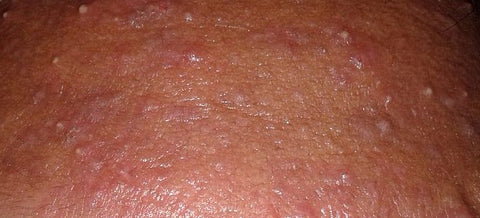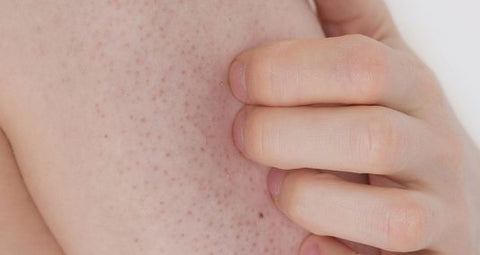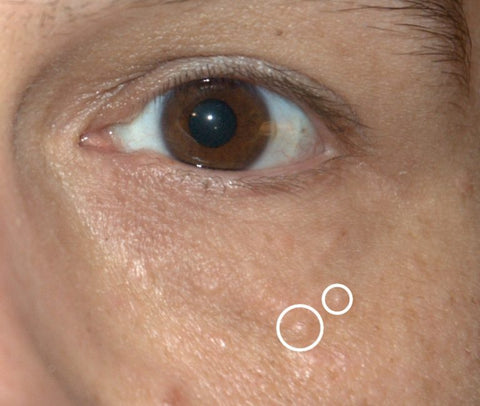
Milia: What They Are and How To Get Rid Of Them
Milia, otherwise known as the pearly-white, hard bumps, milk spots, "stubborn whiteheads" and numerous other names given to them by p'd off hoomans, afflict such a broad age group (from babies upwards) and are one of those things that some of us can easily ignore and some of us can't. It is not acne of any sort, in fact, it doesn't even begin in the pore!
What are milia?
Milia are what occurs when sebum and dead skin cells become trapped in the outer layers of the skin. After a while, they keratinise, meaning that they gather keratin and then harden. We are not angry at keratin as keratin is an essential structural protein of the skin, and keratin looks out for our skin all of the time. It is just that, in this instance, keratin is the culprit of the physical bump.
What do milia look like?
Milia are the type of pearl you don’t necessarily want near your face. They are usually small, round little bumps and they are completely benign. They look a little bit like a regular whitehead but further into the skin and usually are not accompanied by the ring of redness that a whitehead would be. You are likely to get them in multiples, rather than one milium (yes, that is the word for the singular form).
Are there different types of milia?
Milia, like most things in life, come in many forms. You have neonatal milia, which affects nearly half of newborn babies and is mostly commonly found on the nose. Neonatal milia usually disappears within a few weeks of your baby being born, so there is no need to worry. Primary milia affects both children and adults and is most likely to affect the eye region, cheeks and forehead. This type of milia can also heal itself and spontaneously disappear, but some are more stubborn than others and may need a bit of a push (or an excision, to be precise, but more on that later).
Juvenile milia is milia that are caused by hereditary disorders such as Gardner syndrome or nevoid basal cell carcinoma syndrome. If you have a plaque (a type of skin lesion) that is covered in multiple milia, this is called milia en plaque.
You are most likely to find this type of milia behind the ears, around the cheek and jaw area or on the eyelid. Multiple eruptive milia is the name for a rare skin condition in which the sufferer gets repetitive bouts of sometimes itchy patches of milia for a period of time.
It can disappear completely on its own, and it is known to occur in those who have just finished cancer treatment. If you have recently had a skin-related injury, such as a burn or wound, you may develop traumatic milia, which, as you can guess from the name, can happen at the site of skin trauma. Interestingly, you can also get milia after using topical medication, such as steroid creams!
Milia lookalikes
- Acne can be a milia lookalike, especially the mild stage 1 acne that can be found on the forehead, as it is usually small and pearly.

- Seeing as milia are a type of cyst, it is understandable that they can be confused with very, very small epidermal cysts as they look essentially the same.

- It can be quite similar to keratosis pilaris (AKA chicken skin) in how it looks and feels but with KP, the bumps will be spread over a larger area and there will be more of them.

- Syringoma are benign growths that appear very similar to milia as white, yellow or flesh-coloured bumps on the skin. However, syringoma are usually deep into the skin and more difficult to treat. They are permanent and stubbornly recurrent. A medical practitioner will be able to tell you whether your bumps are milia or syringoma.

Can milia be prevented?
Seeing as milia forms for practically no reason, you may feel a little bit disheartened. Some believe it has to do with makeup and eye creams, or that milia are down to dry skin, but I do not believe this to be true - I have oily skin and still get milia!
On the inside: Some nutritionists believe there to be a link between vitamin A and omega deficiency and the development of milia. Although there isn’t a lot of scientific basis behind it, there is no harm in giving vitamin A and omega supplements a go and seeing if it prevents milia from forming for you. Vitamin A and omegas are fabulous for skin health as they help with the skin’s cell turnover and hydration. I’d personally be a fan of Advanced Nutrition Programme Skin Omegas+ and Skin Vit A+.
On the outside: Keeping the skin well-exfoliated may stop the build-up of dead skin cells that lead to the formation of milia. Products that include acids are the best for exfoliation, ie. lactic acid, glycolic acid, salicylic acid. If you get a lot of milia, retinol or retinoids may be a good shout. These vitamin-A-derived ingredients speed up the rate of cell renewal so that dead skin cells are being shed a little bit faster, thus leaving none to become trapped and collect keratin. I'd be inclined to tell people to steer clear of retinols or retinoids unless deemed absolutely necessary, as it can be a relatively harsh treatment.
It is a very common belief that using a lot of products that are too heavy for your particular skin is what causes milia, as it clogs the pore. Seeing as milia does not stem from the pore, I do not think this is necessarily gospel.
How do I get rid of milia?
When it comes to milia, prevention cannot be guaranteed. It is one of those things in the skindustry that isn’t fully understood! However, the one thing that will definitely get rid of your milia is having them professionally lanced. Milia can be lanced in dermatological clinics and some salons. The process is simple and surprisingly not very gory at all, at all.
The surrounding area of the milium or milia will be sanitised thoroughly and a needle (or blade) will be used to pierce the skin. After, the milium itself, the tiny pearl of hardened keratin, will be extracted. Post-extraction, antiseptic will be applied as it is a wound. As the skin has been pierced, you may have a small mark for a few days after the treatment. Sounds simple, yes? Does this mean you should do it yourself? NO!
The main problem with carrying out at-home extractions, when it comes to pores, milia, cysts or what have you, is that the average hooman does not have the skill required to remove what needs to be removed without damaging the skin. Additionally, when it is not their job nor someone else’s skin, people can become very laissez-faire about sterilisation of equipment… Introducing dirty, bacteria-covered tools or fingers to the skin (especially INTO the skin) can lead to infection. Nobody wants that.
Please note that if you are inspired right now to book in to have your milia removed, take care to ask for a manual removal/excision/lancing of the milia! It usually costs around €25 but prices will vary from place to place. On top of having them simply extracted, you can follow the lancing up with epilation or IPL. The heat from these treatments make it less likely for milia to return.
The nerdie recap
Time to look back at what we've learned...- Milia is not acne and doesn't start in the pore
- It cannot be truly prevented
- The main way to do away with them is a professional excision
